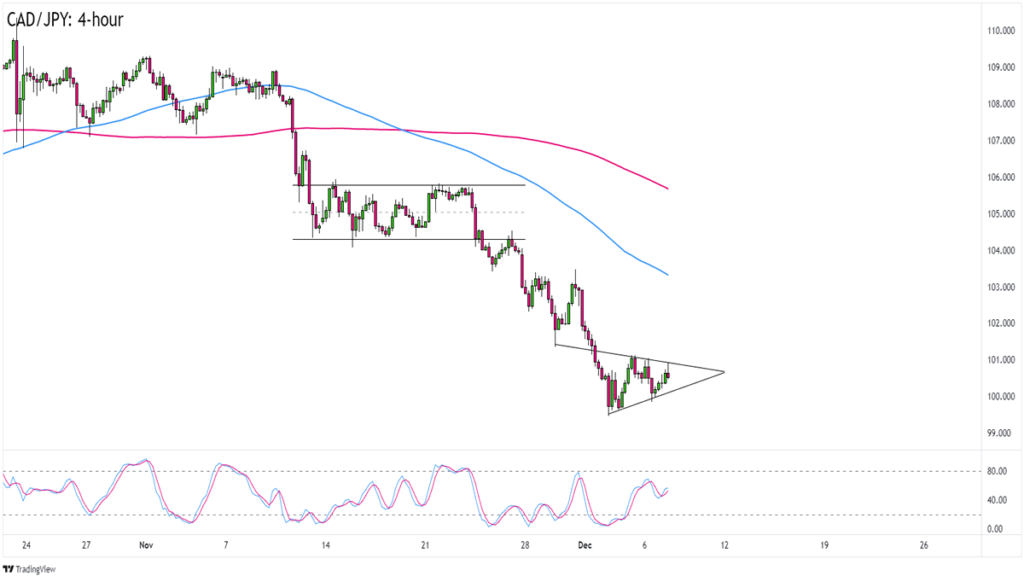[ad_1]
U.S. energy equities weathered the bear market like champs in 2022! So, will we get more of the same in 2023?
What’s been driving the rally and what are the risks to it in the upcoming year?
Energy Select Setor SPDR ETF (XLE)

Energy Select Sector SPDR ETF (XLE) by TradingView
With another likely slow week ahead of the new year, we’re taking another look at a potential longer-term setup, this time in Energy Select Sector SPDR ETF (XLE). This is an exchange traded fund with holdings in companies across the U.S. energy sector like Exxon Mobil Corp., Chevron Corp., and Schlumberger Ltd. It’s mainly traded in the U.S., but exposure to this asset can be found as a CFD with many brokers around the world.
XLE is definitely one to throw into the watchlist for 2023 as a potential hedge to recent bearish price action. Energy company stocks have not only outperformed other risk-on assets, but are even looking to post very positive returns in what has been a brutal bear market for most other asset classes and sectors.
XLE is up over 50% year-to-date, while the S&P 500 (-19% YTD), bitcoin (-64% YTD), bonds (Vanguard Total Bond Market ETF -13% YTD), and gold (-0.70% YTD) are all down. XLE even out performed crude oil prices as Brent Crude oil is only up roughly +7% YTD.
Based on this price action, it looks like U.S. energy companies were one of the main “safe havens” for investor capital this year, likely due to the continued post-pandemic global economic recovery and an oil price spike to $130 a barrel (likely sparked by the Ukraine war earlier this year).
And XLE was able to hold its gains despite oil prices being cut by over 40% from its peak in the second half of 2022, probably due to these companies generating massive revenue and profits in 2021 and likely 2022. Exxon Mobile, for example, has a trailing twelve month (TTM) net income of over $51B vs. a 2021 net income of $23B– likely a more than double increase in just a year…bananas!
So it’s no surprise as to why this sector was an investor favorite, but will it remain so in 2023? As with any idea in the financial markets, it’s always tough to tell.
For the bull case, you’ve got arguments like energy demand quickly rising in the U.S. due to the harsh winter weather, the holiday travel season looking strong for transportation demand, and possibly some demand from the U.S. administration to resupply the Strategic Petroleum reserve to support the U.S. energy sector.
On the other hand, the bears may win out if expectations of a global recession (due to global monetary policy tightening) come to pass and hurts oil demand. This is seen as a highly probable scenario at the moment, especially if China cannot control the surge in COVID-19 cases. Another argument can also be made that energy demand will significantly decrease after the winter season in the U.S. passes.
In addition to those scenarios, there remain questions on oil production levels in 2023 as producers in the U.S., Canada, and Brazil continue to recover, whether we’ll see an increased demand by 2.25M bpd as forecasted by OPEC, and how Russian sanctions and price caps will influence global oil prices and supply. Also, if China can bring COVID back under control and open up their economy, that would have a massive impact on oil demand and prices.
There’s a lot to dig into when it comes to oil markets, but for this watchlist post, we’ve got a bullish short-term lean given the short-term bullish sector fundamental arguments above, and the broad trend higher in prices.
And with XLE dipping lower after failing to break the $95.00 handle in November, it may start to look attractive to the trend riding bulls, especially if there is a retest of the 200 simple moving average marked on the chart above around the $80.00 handle.
That technical setup is what we’ll be watching out for in 2023 and for oil prices and demand to hold as temperatures warm up in the U.S. We’ll also be on the lookout for sector earnings reports coming in late January and early February to get clues on the outlook for the industry going deep into 2023.
But what do you think? Is XLE a buy or should we be leaning bearish, especially on a sustained break below the moving averages and if recession conditions rise?
This content is strictly for informational purposes only and does not constitute as investment advice. Trading any financial market involves risk. Please read our Risk Disclosure to make sure you understand the risks involved.
[ad_2]
Source link


